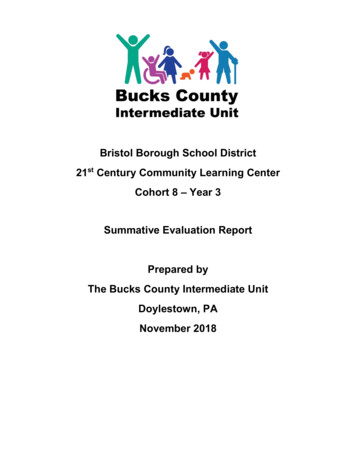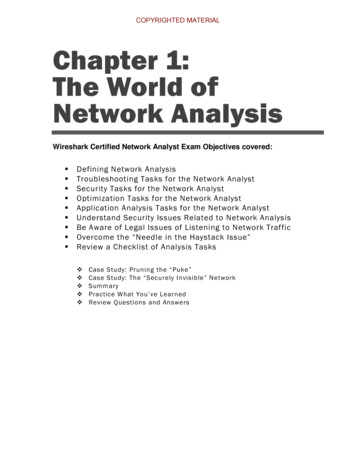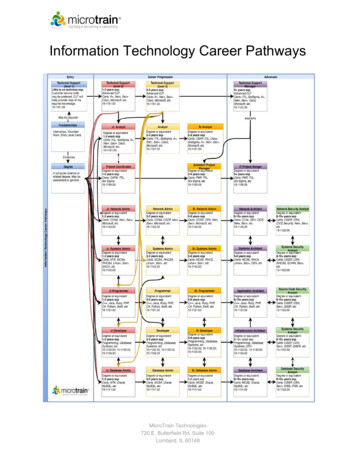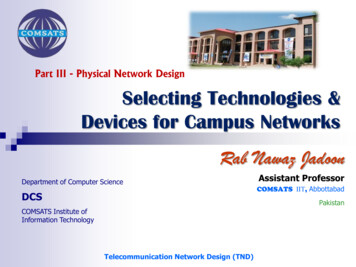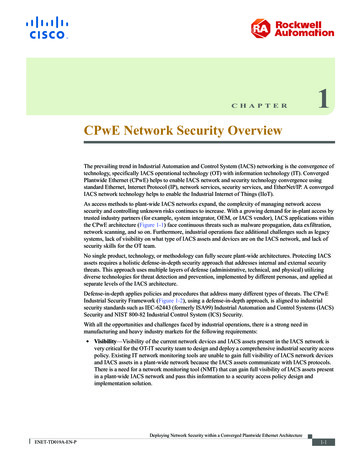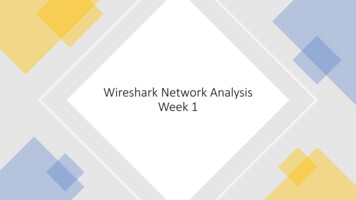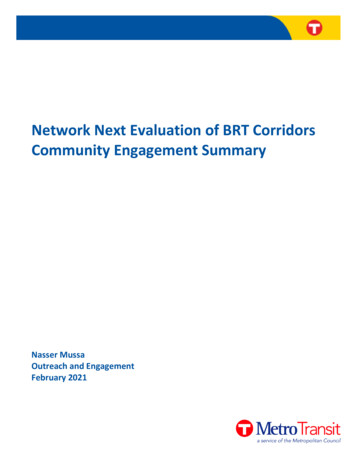
Transcription
Network Next Evaluation of BRT CorridorsCommunity Engagement SummaryNasser MussaOutreach and EngagementFebruary 2021
BackgroundThe Network Next project will develop and communicate Metro Transit’s vision for the 2040 busnetwork, which will guide the expansion of service across the spectrum of network and service qualityinvestments. Network Next planning efforts have been affected by the COVID-19 pandemic. Inresponse to the ongoing public health emergency, some changes have been made to the overallapproach to this project: Planning for improvements to the local and express bus network is on hold. This will allow us tobetter understand the pandemic’s effect on transit needs and incorporate changing ridershippatterns into our planning efforts. We hope to restart local and express bus network in mid2021. Planning for the future arterial bus rapid transit (BRT) network is continuing. This work willidentify the next arterial BRT lines that will open after the METRO E Line. The goal is torecommend the next three BRT lines – the F Line, G Line, and H Line. The outreach andengagement work summarized in this document is focused around BRT planning.Since concluding initial engagement in late 2019, the customers and communities we serve haveexperienced several crises that may affect transportation needs and demands over the next 20 years.This includes increased unemployment, teleworking, health concerns and shared space, and publicsafety.These events have shifted many conversations in the region around equity and priorities. In 2020,Metro Transit decided to focus on the next arterial BRT routes and defer local/express busimprovement planning until 2021. Metro Transit identified 19 potential corridors. That was narroweddown to 11 in Summer 2020. In September, Metro Transit conducted engagement to get public feedbackon the 11 proposed routes and the proposed priorities for prioritizing the corridors for development.In late 2020, we developed concept plans to estimate costs, ridership, and other benefits for 10corridors. We evaluated these using metrics based on what we heard from the public. Based on thatevaluation, we grouped the corridors into three tiers for near-term, mid-term, and longer-termimplementation. This document describes engagement goals and outcomes for identifying the F, G,and H lines from four near-term candidate corridors.Purpose and goalThe purpose of this outreach is to engage the community to assist in developing long range plans fortransit improvements: Summarize background and process to dateShare results from the September engagement processCommunicate how the corridors were prioritized and the top three selected for Tier 1o Public input influenced weighting of principleso Share routes and conceptual station locations, spacing used to estimate costs andridershipCommunicate that corridors slated for mid-term and longer term will be revisited and prioritizedwithin the next five yearsSeek input on which corridor should be prioritized as the F LineNetwork Next Engagement Summary February 20211
The goal is to engage with the community and receive at least 2,000 responses with 45% of theresponses from Black, Indigenous or People of Color (BIPOC). The target audience is transit users andcommunities served by the core and suburban local routes.Methods of engagementThe targeted audience was riders, potential riders and general community. Inability to hold orunwillingness of people to attend meetings due to COVID-19 continued to be a challenge. However,Metro Transit continues to try strategies to engage a diverse set of stakeholders. Direct people to webpage for information with engaging visual content and easilyunderstandable maps Target ethnic and local media via social media, website, print ads, and advertorials in localpublications Emails to current transit users Online survey in English, Spanish, Somali and Hmong In-person intercept surveys as reasonable given COVID and limitations Posters with a QR code to the survey were put at 100 busy shelters to engage ACTIVITYMshale Print Newspaper Advertorial: 28,000 paper circulationHmong Times Print Newspaper AdvertorialSurveyMonkey survey goes live in English, Somali, Hmong, and Spanishmetrotransit.org/network-next posted with information about Network Next, previousreports, video about Network Next and link to the surveyStar Tribune posted an article about Network Next surveyNews article on metrocouncil.org websiteArticle included in the Metropolitan Council’s monthly e-newsletterPosters installed in 100 shelters along the 10 routes with information about NetworkNext and QR code to the surveyInformation packets with materials, maps, graphics, and presentation sent to citiesand counties so that they could updates to their elected officials and pushinformation out via their newsletters, social media, and websitesInterview with MPR reporter for article posted 12/10News article on metrotransit.org websiteArticle included in internal newsletter Insights with promoted Network Next surveyinformationEmail to 2019 Network Next engagement grantees with project update and packetof information if they’d like to help us get the word outNetwork Next e-newsletter to 500 subscribers via GovDeliveryPublished advertorial in Spokesman Recorder with link to survey as well as socialmedia and web ads.Network Next Engagement Summary February 20212
erview with Pioneer Press reporter for article posted 12/14Email to 43,000 Go-To Card users and Metro Transit App users that use at least oneof the 11 routes that mimic the proposed BRT corridorsRiders Club e-newsletter with project update and link to the website, interactivemap, and surveyEmail to Minnesota Ethnic Councils (African Heritage, Asian Pacific, Latino Affairs &Indian Affairs Council) with information and request to help get the word out728x90 web banner on Mshale.com Impressions 15,123. Clicks 3,921.Connect e-newsletter sent out with update on Network Next and how to submitcomments1/12/21Minnesota Spokesman Reporter Facebook Live event to talk about Network Nextsurvey and how BRT will serve communities better. 345 views of the event;338video views.1/15Mshale eNews Exclusive mailed to 15,282 subscribers. Opens 7,923. Clicks 2,929.1/19Mshale eNews Exclusive mailed to 15,293 subscribers. Opens 7,971. Clicks 3,013.1/19-1/20 Minnesota Spokesman RecorderRebroadcast video 76 views, MSR sent email to 145 community organizationsplus Neighborhood Executive Directors. Print impressions: 80,000. Websitebanner impressions: 126,000 with 36 clicks.Email marketing to 50,000 subscribers with total opens 7,224 and total clicks 1,159MSR- amplified social media outreach (Twitter and Facebook) 12,000 peoplereached, 10,000 engagements.Social mediaSocial media was used to get word out about the survey. We also used it in a new way to prompt anonline discussion. We posed a question and encouraged people to respond in the comment. Many ofthe questions received good response.POSTED POST DESCRIPTION12/912/912/1012/11Video about this phase of Network Next onYouTube. 1,036 views on YouTubeShared proposed posts with Minneapolis, St.Paul, Ramsey Co., and Hennepin Co. socialmedia staffFB and Twitter posts with a short video aboutNetwork Next, encouraging people to completethe surveyFB and Twitter posts with a map link to thesurveyNetwork Next Engagement Summary February 2021FACEBOOKTWITTER48 shares14 comments40 likes/hearts6,400 views6 shares2 comments2 comments43 retweets40 hearts3,858 viewsno comments7 retweets3
POSTED POST DESCRIPTION12/1212/15Robin Caufman posted on LinkedIn and askednetworks to share; shared by Councilmembersand community organizations.Map of Central (Route 10) corridor and link tosurvey12/22Map of Como/Maryland (Route 3) corridor andlink to survey1/5Map of Lyndale/Johnson (Route 4) corridor andlink to survey1/12Map of Rice/Robert (Route 62/68) corridor andlink to survey1/15Reminder to take the survey and repost video1/19Last call post with new graphicFACEBOOKTWITTER25 likes/hearts13 hearts7 shares16 comments25 likes/hearts2 shares8 comments13 likes/hearts2 shares5 comments10 likes/hearts4 shares4 comments19 likes/hearts3 shares10 comments13 likes/hearts4 shares2 comments9 likes/hears2 comments11 retweets24 heartsno comments2 retweets7 hearts1 comment3 retweets8 heartsno comments2 retweets6 heartsno comments11 retweets8 heartsno comments7 retweets6 heartsIn-person surveysStaff went to busy transit centers, light rail stations and bus stops to survey people in person. Peoplewho completed the survey were offered a free ride pass. In addition to the in-person surveys, we hadbusiness cards printed with the URL and QR that directed people to the survey.DATE t Bank StationSt Paul - Capitol/Rice StationSt Paul – Minnesota & 5thColumbia Heights TransitCenterMall of AmericaNorth Town MallRosedale MallSTAFFRobin Caufman & John StephensJames Holt & Nasser MussaJames HoltYumi Nagaoka & Joanna Hubbard-RiveraJuan Rangel & Nasser MussaYumi Nagaoka & Joanna Hubbard-RiveraCody Olson & Doug CookCommunity and virtual meetingsDATE ORGANIZATIONNetwork Next Engagement Summary February 20214
12/15 Robin emailed St. Paul and Minneapolis communications staff with information andrequest to help get the word out; Nasser emails to city managers at suburban cities.12/15 Nasser emailed information to Arden Hills, Brooklyn Park, Bloomington, Burnsville,Columbia Heights, Coon Rapids, Crystal, Eagan, Edina, Falcon Heights, Lauderdale,Lilydale, Little Canada, Maplewood, Mendota Heights, Mounds View, New Brighton, NewHope, North Saint Paul, Oakdale, Richfield, Robbinsdale, Rosemount, Roseville, SpringLake Park, St. Anthony Village, St. Paul Park, Stillwater, Vadnais heights, White BearLake, Woodbury1/10 Letter of support from Como Student Community Cooperative for Como/Marylandcorridor.1/11 City of West St. Paul letter of support for Rice/Robert corridor.1/17 City of Saint Paul letter of support expressing their top priority is Rice/Robert andsecondary support for the Como/Maryland corridor.1/19 Dakota County resolution of support for Rice/Robert corridor.1/19 Dakota County Chamber of Commerce letter of support for Rice/Robert corridor.1/20 Ramsey County Public Works letter of support for Rice/Robert corridor.1/20 Rice & Larpenteur Alliance letter of support for the Rice/Robert corridor.Survey respondentsOver the course of a month, we heard from more than 4,116 people of which 119 were inperson. BIPOC respondents accounted for 31% of the total surveys completed.RACE/ETHNICITYAmerican Indian/Alaska NativeAsian/Asian AmericanBlack/African AmericanHispanic/LatinxMultiple IdentifiedOther %69.2%Network Next Engagement Summary February 20215
Our second measurement of success was to engage communities that are served by our core andsuburban local bus routes. We collected ZIP code data in our online and in-person surveys andmapped the responses that shows the respondents with highest concentration of responses were fromareas served by core and suburban local service.Network Next Engagement Summary February 20216
Analysis and key themesThe survey is not a direct vote to select the METRO F Line. However, the feedback received wasconsidered in the analysis that led to the staff recommendations.The survey showed strong community support for each of the four corridors considered. The Central(Route 10) and Como/Maryland (Route 3) corridors were the highest priorities with 28.5 percent and27.9 percent of respondents selecting their top priority. Common reasons cited for selecting thesecorridors were: Provide service to BIPOC communitiesProvide service to areas not currently served by bus rapid transit or light rail linesConnections to home, work, school, stores, and key destinationsBy corridor, here are the main reasons we heard for why people selected routes as their top priority: Central (Route 10)o Serves northeast Minneapolis, northern suburbso Serves BIPOC communities and provides access to places they shop and socializeo Dense population, high ridershipo Close to home, work, schoolo Need more frequent, faster and reliable transportation Como/Maryland (Route 3)o East-west service between Minneapolis and St. Paulo Connection to neighborhoods, key destinations and UofMo Close to home, work, schoolNetwork Next Engagement Summary February 20217
Rice/Robert (62/68)o Serves low-income and BIPOC communitieso Improves north-south connections, crosses major physical barriers (the river, the railyards)o Connections between high density areas, apartments and retailo Advances equity and provides geographic balanceo Opportunity to improve to speed and reliabilityJohnson/Lyndale (4)o Links south Minneapolis with northeast Minneapolis via downtowno Connects many neighborhoods, shopping areas, and business districts.o Provide high frequency transit in growing community currently underserved by transit,specifically in northeast.o Lyndale is highly traveled corridor where improvements could increase transit speed andreliability as well as safetyHow we are using what we heardThis report will be shared with the public by posting it online and presenting it to stakeholdergroups. The data was used by the Network Next project team to recommend the F, G, and H lines. Thedata was shared with staff working on other transit improvement projects so that they can look for anycomments and concerns as they resume planning and engagement for those initiatives.Network Next Engagement Summary February 20218
Appendix A: Sampling of commentsFollowing is a sampling of comments in respondents’ own words about each of the four corridors.Central (Route 10)“Northeast is not well served by transit and has poor connections to the rest of Mpls and the metro. It'sthe only part of the city that doesn't already have current or planned LRT or BRT. Poor transitconnections and long travel times are an obstacle for anyone in NE trying to get to work or otheropportunities outside the neighborhood. Advancing this route first would also be an opportunity toincorporate these plans with the current MNDoT planning process for the Central and Universitycorridors, which will otherwise be significantly affected if BRT plans are introduced later.”“Racial equity - it has some of the most transit dependent populations - they don't have lrt - if theprotests taught us anything, we need investment in our poorest neighborhoods.”“Because central is loaded with mom and pop, bipoc owned small businesses catering to a wide swathof bipoc customers. AND the surrounding area has a great many lower income households. This linewill connect many services industry workers to other bus lines and speed up the time it takes to travelto multiple jobs they need to survive but are now spending hours of potential family time on travel.”“I am a property owner in Fridley. The number of rental and housing units in Fridley is growing rapidly.The commuter line is excellent for moving people who work traditional work hours, however manyresidents of Fridley do not work traditional hours. Having additional bus access would bring newopportunities to a community that is growing in number and diversity.”“This corridor access/reaches many blighted communities. This could help revitalize some of thesecommunities and help businesses along Central Avenue.”“It's really the heart of mass transit for NE at least running north and south. It gets a lot of people wherethey need to be, even out to the suburbs/Northtown where ppl can work. Improved stations (heat inwinter/shade in summer) would make it better for those who rely on the 10.”“The northern part of the Twin Cities is inadequately served by transit - especially if trying to get to StPaul. The State is one of the largest employers in Minnesota and most of the jobs are in St Paul butpeople living in the northeast Mpls and north eastern suburbs are completely cut off from adequatetransit.”Como/Maryland (Route 3)“The Como/Maryland corridor is my top priority because it is a heavily used route by a widerange of passengers (commuters, students, visitors to Como Park, general passengers, etc.).The corridor is also a very socioeconomically diverse area, and more efficiently connectingthose different neighborhoods is in line with the priorities for these rapid transit routes, as wellas the long term priorities of the cities of Saint Paul and Minneapolis. The additional amenitiesNetwork Next Engagement Summary February 20219
and speed of bus rapid transit along the Como/Maryland corridor would benefit all of these differentriders and be a step in the right direction towards achieving these priorities.”“Como/Maryland is a huge corridor that serves (at least close to) all 3 UMN campuses andboth downtown. A huge proportion of students live in the residential areas served by this corridor,as well as thousands of non-student workers for both downtowns. Moving people through this area aseffectively as possible is a must, congestion and overcrowding on busses happens very quickly.”“The Como/Maryland corridor provides a vital east-west connection for many riders. I used to rideRoute 3 myself and always thought it would be a good candidate for investment to increase frequency /capacity / and improve travel times.”“Many people in the diverse neighborhoods of the East Side do not have cars or access to convenientmass transit. The bus routes in this area meander and do not provide quick access to downtown StPaul where many need to transfer to get to their destinations in MPLS. This route with a straight shot tojobs in the MPLS core would be a boon to East Side families.”“The east metro area desperately needs to be better integrated into the metro with BRT or better. Theequity case is also strong - the northern areas of Saint Paul are full of lower income residents andimmigrant families who could benefit from not only high-speed transit to jobs and other life destinations,but also would benefit from the incremental development attention that the BRT would bring to the area.Small businesses would see more access to dollars, vacant homes would see demand from potentialowner-occupants, and the a car-free life would be supported through enhanced mixed-modaltransportation offerings.”Johnson/Lyndale (Route 4)“The Johnson-Lyndale corridor connects low-income residential areas with both the Quarry shoppingarea and downtown, serving equity and transit-oriented development goals.” “The Johnson/Lyndaleroute will connect a number of transit ready communities and provide high frequency service in areascurrently underserved by transit, most specifically in Northeast.”“Right now there aren't many good ways to connect from South Minneapolis/ Richfield/ Bloomington toNE Minneapolis and St. Anthony without making a transfer downtown. This corridor would be great forthose who live and work on opposite sides of downtown and don't want to make a transfer there. Itconnects lots of businesses, shops, housing, and entertainment districts that are more difficult to reachotherwise.”“Johnson/Lyndale appeared to be the longest corridor of the listed options. It's compelling to me that itwould connect Columbia Heights/St Anthony to Bloomington, through downtown Mpls. Additionally, inmy work, I'm familiar with real estate development in the Minneapolis neighborhoods along this routeand the increasing housing densities would be well served by BRT. Worth considering, the Minneapolis2040 Comp plan aims to diversify incomes in all neighborhoods. That means more potential transitriders in current "car first" neighborhoods.”“The routes to and from that area of the metro (Silver Lake Village Area in St. Anthony) are slow andthere are a number of apartment complexes in that area (with a new one currently under construction).Network Next Engagement Summary February 202110
Rapd Bus Route to and from this area would increase accessibility to Downtown Minneapolis. Also,there appears to be adequate space to accommodate whatever infrastructure will be needed.”Rice/Robert (Route 62 and 68)“Robert Street is a vibrant area serving a large number of people, many of whom are minorities andtransit users. Ramsey and Hennepin have TONS of lrt and BRT options. This corridor makes a lot ofsense, especially when you look at it graphically compared to the existing network. Will serve a lot ofpeople and help all those businesses in west St. Paul with added shoppers. There isn’t a corridor likeRobert street in west St. Paul anywhere with that much retail. A lot more apartments are coming too.”“This serves the heart of Frogtown neighborhood and the North End of St. Paul which are low incomeneighborhoods. Extending the BRT from downtown to Shoreview helps pull people to jobs on both endsand through St. Paul .Equity issues, particularly the large concentration of rental residents in WestSaint Paul who are currently underserved with public transit.”“Robert Street has everything; groceries, restaurants and every type of retail. Add to that all of thesenior and market rate apartments being built or in the pipeline. Transportation like this is critical forthese populations and also provides access to St. Paul. All of the commercial on Robert also requiresworkers. These are not overly high paying jobs so transit reliant workers are abundant. It would alsoallow those from Rice area to come to WSP to work and shop; and vice versa,”“This corridor is a critical North/South corridor for Saint Paul and bus rapid transit would be a hugeimprovement over current options. This corridor would serve transit dependent populations and alsohas potential for great walkable urban environment.”“Rice/Robert bridges major gaps (the Mississippi River and I-94), and runs through areas of St. Paulthat have been all-but ignored and divested from for decades. It hits diverse areas and areas ofconcentrated poverty. Along with the Gold and Rush Line BRT, it will significantly improve access todowntown St. Paul, which badly needs this investment, and all three lines would benefit from theirshared BRT stations through downtown.”Network Next Engagement Summary February 202111
Appendix B: Samples of social media, news Network Next Engagement Summary February 202112
goal The purpose of this outreach is to engage the community to assist in developing long range plans for transit improvements: Summarize background and process to date Share results from the September engagement process Communicate how the corridors were prioritized and the top three selected for Tier 1


